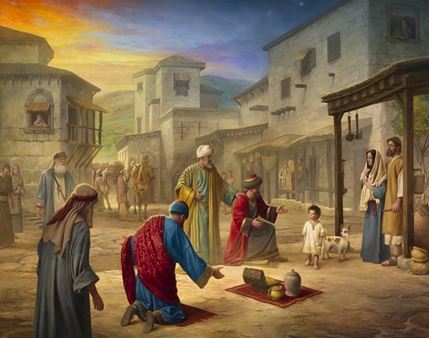What Child Is This?
“Child of Prediction”
Luke 2:39-40, Matthew 2:1-12
Wayne J. Edwards, Pastor
In our first sermon, we saw Jesus as the “Child of Promise.”
- In Genesis 3:15, God said a child would be born who would defeat Satan, and while Satan would try to destroy the seed line through which that child would be preserved, by His death and resurrection, that child would eventually crush Satan’s head and set free those in bondage to sin.
- According to Matthew’s genealogy, that “Seed from Eve” passed through 42 selected and protected generations until “Jacob began Joseph the husband of Mary, of whom was born Jesus, who is called Christ.” (Matthew 1:16)
- In Galatians 4:4, the Apostle Paul confirmed this when he wrote, “When the fullness of the time came, God sent forth His Son, born of a woman, born under the Law, that He might redeem those who were under the Law, that we might receive the adoption.”
In this sermon, we will see Jesus as the “Child of Prediction.”
- Around 1400 B.C., the prophet Balaam predicted the birth of the Messiah God had promised Israel.
- In Numbers 24:17-19, Balaam said, “A Star would come out of Jacob, and a Scepter shall rise out of Israel.”
- The word “star” referred to a human leader who would be the light of the world.
- The word “scepter” referred to the “deity” of that leader who would one day rule the world.
- Around 539 B.C., the prophet Daniel told a group of Persian astrologers called “Magi” the New Prince of Israel would arise 483 years after the Persian Emperor allowed the Jews to return to Israel and rebuild the temple. That release occurred around 533 B.C.
- So, somewhere around 6 B.C., when the “Magi” saw that bright star in the East, they were convinced the prophecies of Balaam and Daniel had been fulfilled, and they began their journey to Israel to worship this new king.
- Therefore, Jesus was also the “Child of Prediction.”
In our proclamation of the gospel, especially at Christmas, we must focus on the essential and eternal truth of that historical event and not the trivial and temporal fable.
- While the events of this heart-warming story may inspire us for the moment, unless that Baby was the Savior sent from God to redeem us from our sins, the historical narrative is insignificant to the predicament in which we live.
- Jesus did not come to earth to create a holiday. Jesus was born to die for sinners.
- However, if His death was sufficient payment for the sins of all who will believe in Him, He had to be more than a man.
- The undeniable, verifiable, and demonstrable truth of Christmas is that the babe in the manger, who was born to be our Savior, was absolute deity, and worthy of our worship and praise.
- Even the Persian astrologers said:
“We have seen His Star in the east and we have come to worship Him.”
Matthew 2:2
To understand the whole story of Christmas, we must weave the unique purposes of the four gospels into one picture.
- The purpose of the gospel of John was to prove Jesus’ deity – John 1:1-14, and John 20:30-31.
- The purpose of the gospel of Luke was to prove Jesus’ humanity – Luke 1:1-4
- The purpose of the gospel of Mark was to present Jesus as the Suffering Servant – Mark 10:45
- The purpose of the gospel of Matthew was to use His genealogy and His fulfillment of over 300 specific Old Testament prophecies to prove to the Jews that Jesus was the long-expected, God-promised, and God-sent Messiah – that He was the Child of Prediction.
1. The Declaration of the Wise Men – Matthew 2:1-2 – “Where is He that is born King of the Jews, for we have seen His star in the east, and are come to worship Him!”
- Let’s correct the record:
- Matthew did not say there were three wise men. That addition to the Christmas story came from an unbiblical medieval legend.
- Matthew did not say there were three kings. “Magi” is the plural of the Latin word “Magus,” the name given to those who studied astrology and started the religion of Zoroastrianism.
- Matthew did not say the star rested over the barn in Bethlehem. These men were “in the east” when they saw the star. Had they followed an “Eastern star,” they would have ended up in China or India, not Israel.
- Matthew did not say the Magi worshipped the baby Jesus in the barn at Bethlehem. It took two years or more for these men to travel over 1000 miles from Persia to Jerusalem.
- Matthew 2:9 – “The star, which they saw [while] in the east, went before them, till it came and stood over where the young child was.”
- Matthew 2:11 – “And they came into the house and saw the young child with Mary, his mother, and they fell down and worshipped Him.”
- God put these historical events in order for a purpose, and if we are going to tell the whole gospel story, it is imperative that we get it correct.
2. The Intimidation of the Wicked King – Matthew 2:3-8 – “When Herod the king had heard these things, he was troubled, and all Jerusalem with him.”
The arrival of this entourage from the East disturbed many people in the city of Jerusalem.
- Although King Herod was a practicing Jew, he was not a loyal Israelite because he used his position to amass a fortune for his family.
- Herod was so disturbed by the news that a new king of Israel had been born he devised a way to preserve his position.
- After his scribes and chief priests told him the prophet Micah said a new governor would come out of Bethlehem, Herod ordered all male children, two years of age and younger, who lived near Bethlehem to be killed.
- Although the people of Israel longed for God to send the Messiah, they were disturbed by Jesus’ demands for discipleship.
- It should have embarrassed the Jews that Gentiles were the first to recognize the birth of the Messiah.
3. The Adoration of the Glorious King – Matthew 2:9-11 – “And when they were come into the house, they saw the young child with Mary, His mother, and they fell down and worshipped HIM; and when they had opened their treasures, they presented unto HIM gifts; gold, and frankincense, and myrrh.”
The Hebrew word that is translated in our Bibles as “worship” means to “bow down, to do homage,” and the Greek word that is translated as “worship” means to “show reverence to the one who is worthy of it.”
- When we bow down before God, we are not only proclaiming His worth to the world, we are showing our submission unto Him.
- The Maji’s worship of Jesus included gifts:
- Gold – recognizing His royalty.
- Frankincense – recognizing His holiness and compassion for the people.
- Myrrh – recognizing the need for His death as the sacrifice for our sin.
- While Herod saved his throne, he lost his soul forever.
- While the wise men lost themselves in their worship of the Lord Jesus, their souls were saved forever.






